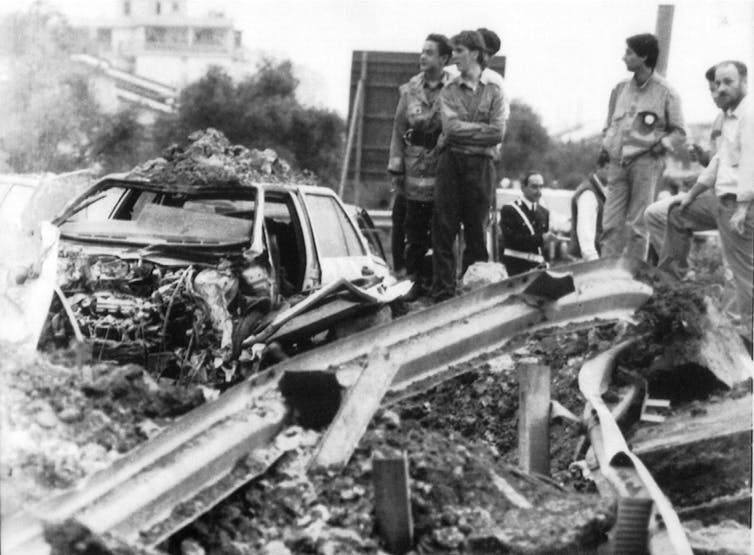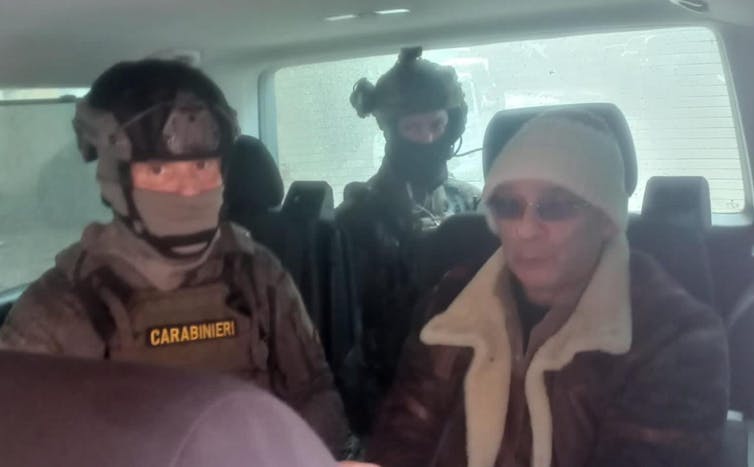The arrest of Matteo Messina Denaro, one of Sicily’s most infamous mafia bosses, has reminded many Italians of the extreme violence he was associated with when operating as a leading figure of Cosa Nostra.
Denaro appears to belong to another time – when the mafia brutally killed at will. And it is indeed true that the period of extreme violence with which he is associated has been confined to the past. But that does not in any way mean Italy’s organised crime groups have disappeared in the 30 years Denaro has been in hiding – they’ve just had a rethink about how they operate.

The Italian mafia has drastically reduced the number of homicides it carries out. Violence is now used in a much more strategic and less visible way. Rather than bloody and conspicuous murders, the modern mafia intimidates with crimes that are less likely to be reported to the police – such as arson and physical assault or sending threats. Murder is now a last resort.
The violent conflict between the Sicilian mafia and the Italian state reached its climax in the early 1990s. This was a period characterised by massacre after massacre, including the notorious bombing on Via D’Amelio in 1992 that killed magistrate Paolo Borsellino and five members of his entourage. In 1991 alone, there were 1,916 homicides – 718 of which were of a mafia nature.
THE MAFIA AND CULTURAL IMAGINATION
The media covered every twist and turn. Politicians spoke in parliament about the scourge of organised crime. Mafia activity occupied a significant place in Italy’s public discourse and cultural imagination.

The authorities reacted with force. New laws were enacted, such as the “41-bis” prison regime, which included the threat of solitary confinement for members of organised crime gangs. A local municipality could be stripped of its powers for up to two years if local officials were thought to be working with the mafia, and a nationally appointed technocratic administration installed to clean house. A national anti-mafia directorate was also created so that more resources could be dedicated to the fight against organised crime.
In the years that followed, data shows a radical decrease in the number of mafia-related homicides, from 718 in 1991 to just 28 in 2019. In 2020, there were 271 homicides in Italy, compared with almost 2,000 in 1991. With 0.5 homicides per 100,000 inhabitants, Italy now has the fewest homicides in Europe after Iceland and Slovenia – fewer homicides per capita than Norway, Switzerland or Luxembourg.
At the same time, an interesting trend can be identified. In ongoing research, I’ve been analysing the archive of RAI (Italian National Television) over the past 40 years and studying the content of national and regional news bulletins. It’s clear that in years with more mafia homicides, media coverage related to the mafia increases, measured by the percentage of news on the mafia topic.
Conversely, when mafia homicides decrease, the topic is talked about less and there are fewer interventions in parliament. For example, between 1992 and 1994, organised crime was cited in 15% of speeches by parliamentarians. Within 20 years it was being mentioned in just 4.3% of speeches.
In other words, the more the mafia openly kills, the more attention it attracts from the media and politicians. It’s important to note that these are not necessarily years in which the mafia has been any less active in other ways. The smuggling, racketeering and corruption continues unabated. Only the most noticeable violence is in retreat.
UNREPORTED AND UNNOTICED
All of this suggests that the decrease in the number of homicides could, at least in part, be a strategic choice. Criminals have worked out what they need to do to fly under the radar and be left to their own devices.
This does not mean that violence is no longer used – it is simply more targeted. As reported every year by the anti-mafia charity Avviso Pubblico, local administrators are now the main targets of the mafia. They are sent threatening letters and are treated with aggression in person at a rate of about one incident per day. This phenomenon goes almost unnoticed by the media, which would surely pay attention were a member of the national parliament face intimidation or violence. At best, local officials might see their experiences reported in the local press; it’s rare for such incidents to be reported on at a national level.

The mafia thereby neatly achieves its goal of influencing local politics without attracting media and political attention. Election periods are particularly delicate: mayors are subject to the most threats at these times, particularly in the period immediately after taking office, as local criminals see an opportunity to take control of the newcomer.
This strategy has facilitated the mafia’s economic expansion. While the number of murders has declined, the number of properties and businesses seized from the mafia has ballooned – again suggesting that a drop in violent crime is not necessarily an indicator of a drop in other types of criminal activity. In 1991, the state seized two companies and four properties from the mafia. In 2019, 351 companies and 651 properties were seized.

These figures could be read as indicating that law enforcement is doing a better job of identifying economic crime, and that could indeed be the case. But other data lends weight to the more pessimistic interpretation of the facts.
In 2019, assets relating to organised criminals were seized in 11 Italian provinces (largely in the northern regions) that had never previously experienced mafia activity. And today, each police operation related to organised crime leads to seizures of about €1 million (£880,000). At the end of the 1990s, the average value was about €50,000.
This suggests that far from being in retreat, the mafia is expanding into new areas of the country, and finding more lucrative opportunities as it goes.
—
This article originally appeared in The Conversation and was written by Gianmarco Daniele Assistant Professor at University of Milan and Executive Director of the CLEAN Unit on the economics of crime at Bocconi University, Bocconi University
